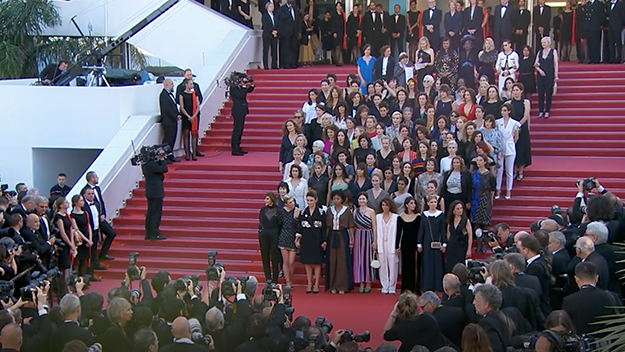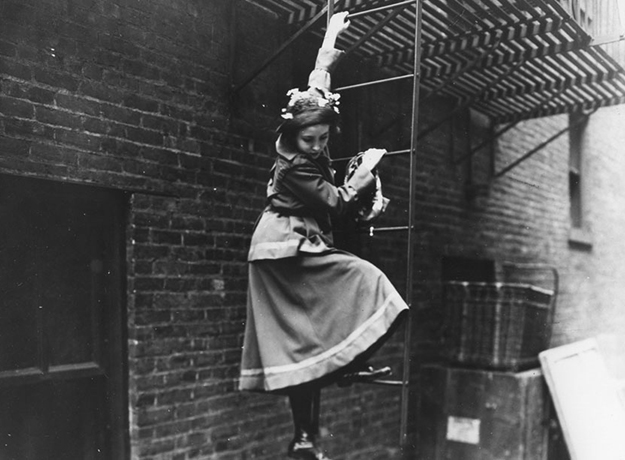Cannes Report #3: Women in Film, Now and Then

Photo by Eugene Hernandez
Fifty years ago here in Cannes, a group of filmmakers led by Jean-Luc Godard and François Truffaut famously shut down the festival amid the May ’68 protests and strikes that were lighting up the country. Politics have defined Cannes 2018 as well. As this year’s edition reached its midpoint, activism dedicated to questioning the historical treatment of women at the festival has become central.
The biggest public statement was made on Saturday, as 82 women, each representing one female-directed film that has screened here throughout the entire history of the competition, walked together on the red carpet (by contrast, 1,645 selections have been directed by men). Among those in the group were Alice Rohrwacher, Ava DuVernay, Claudia Cardinale, Jane Fonda, Kim Longinotto, Kristen Stewart, Marion Cotillard, Patty Jenkins, and Salma Hayek.
At the front, Agnès Varda and Cate Blanchett stood next to each other and read from a statement, in both French and English: “Women are not a minority in the world, yet the current state of our industry says otherwise. We will demand that our workplaces are diverse and equitable so that they can best reflect the world in which we actually live. A world that allows all of us behind and in front of the camera to thrive shoulder to shoulder with our male colleagues. The stairs of our industry must be accessible to all. Let’s climb.”
Activist efforts here have been led by a coalition of groups from multiple countries, created in the wake of #MeToo, including Time’s Up U.S. and Time’s Up UK, Italy’s Dissenso Comune, CIMA from Spain, and Women’s Wave from Greece. Chief among them is 5050×2020, a French group promoting gender equality. This morning, they enlisted Thierry Frémaux and organizers from other sections at Cannes to sign the Programming Pledge for Parity and Inclusion in Cinema Festivals. Signing it means vowing to compile statistics on the genders of filmmakers submitting work, maintaining transparency in programmers and selection-committee members, and trying to achieve parity in the ranks of executive festival leadership. Cannes was the first to sign; 5050×2020 will enlist other festivals to join them.
*****

The Great Adventure
An important female filmmaker more people ought to know about got a Cannes spotlight this year: Alice Guy-Blaché, one of cinema’s first filmmakers, producers, and entrepreneurs, and a contemporary of the Lumière Brothers, Thomas Edison, and George Méliès. After being employed as a secretary to French studio founder Léon Gaumont in her twenties, Guy-Blaché was tasked with writing and then directing films, initially at Gaumont and later on her own. In 1910, she built and led the studio Solax in New Jersey. It is now believed that Guy-Blaché may have made as many as a thousand films.
Pamela Green, a title and graphic designer who also works in archival footage, first learned of Guy-Blaché when watching an AMC documentary called Reel Models: The First Women of Film about 15 years ago. “This was a pioneer,” Green told me yesterday after a screening of her new documentary, Be Natural: The Untold Story of Alice Guy-Blaché, which was shown in unfinished form as part of the festival’s Cannes Classics section. “Filmmaker. Producer. Studio owner. There was so much creativity and artistry in one person.”
Her interest piqued by Reel Models, she started asking people if they had heard of Guy-Blaché. Many had not. “It bugged me,” Green said. “I felt I had to do something about it. I could relate to her determination. I became completely obsessed.”
Green spent the next eight years writing—and righting—a history. Her work on the project amounted to extensive detective work. Years of research began with access to Guy-Blaché’s diaries, papers, photos, and even her personal address book. Ancestry.com also became a key tool. Green cold-called Guy-Blaché’s family, friends, and contemporaries, often connecting with their kin to find artifacts and flesh out the story, unearthing lost films she directed or produced. The director secured financial backing from Robert Redford, and Jodie Foster signed on to narrate. Like most of those who became involved in the film, Green says they were both unaware of the volume of Guy-Blaché’s output. The documentary features interviews with familiar faces (including Agnès Varda, Geena Davis, Ava DuVernay, Ben Kingsley, and Julie Delpy), while animation, graphics, and audio clips depict some of Green’s research efforts, including phone calls, meetings, and conversations with actors, archivists, filmmakers, and members of Guy-Blanche’s family.
In her later years, Guy-Blaché worked to preserve her own legacy against those who would downplay, ignore, or try to erase her work. For instance, Green shows evidence of historians attributing her films to others—such as with 1896’s La Fée aux Choux (The Cabbage Fairy), considered one of the first known narrative films. The documentary also passingly implicates Henri Langlois, the legendary archivist and preservationist who co-founded the Cinémathèque française and Daniel Toscan du Plantier, former head of Gaumont and Unifrance, who at times doubted or undermined Guy-Blaché’s role and influence. Guy-Blaché was left out of an official published history of Gaumont, and though she was to be included in a second edition, the death of the company’s namesake founder killed the project. In her later years, Guy-Blaché—seen in rare interview footage—fought to reclaim her legacy and even find some of her lost work; she also agonized over her inability to find a publisher for her memoirs before she died in New Jersey in 1968.
Green says she’s still working to refine the documentary, looking for more funding to complete the editing. “We need more resources to finish. Everything helps,” Green noted. “She’s like a puzzle that we keep putting together. I think this film shatters history a little bit. It’s going to influence more filmmakers—more female filmmakers who will influence the next ones.”
Eugene Hernandez is Deputy Director of the Film Society of Lincoln Center and Co-Publisher of Film Comment.







